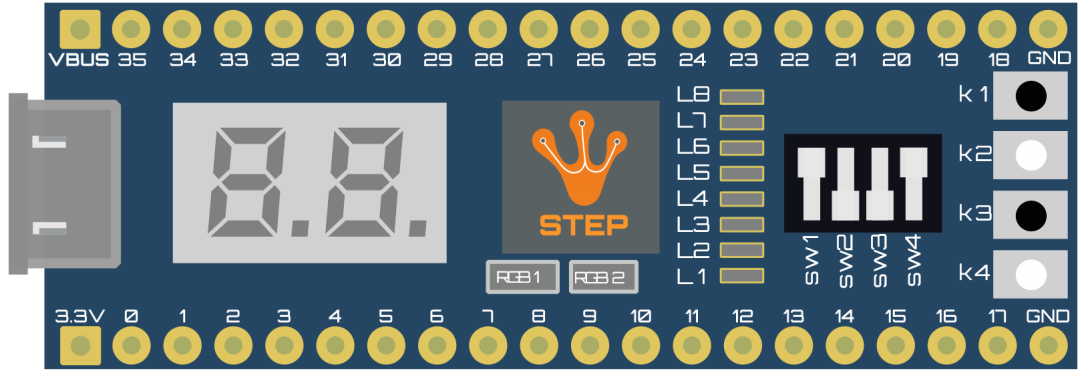单片机控制数码管显示:科学研究的显示助手
发布时间: 2024-07-13 07:45:56 阅读量: 29 订阅数: 37 


# 1. 单片机基础**
单片机是一种集成电路,它将中央处理器(CPU)、存储器(RAM和ROM)、输入/输出(I/O)端口和各种外围设备集成到一个芯片上。单片机通常用于嵌入式系统,例如数字时钟、温度显示器和汽车电子设备。
单片机具有以下特点:
* **低成本:**与微处理器相比,单片机具有更高的集成度,从而降低了成本。
* **低功耗:**单片机通常设计为低功耗操作,使其非常适合电池供电的设备。
* **紧凑尺寸:**单片机集成在一个芯片上,使其非常紧凑,非常适合空间受限的应用。
# 2. 数码管原理与驱动
### 2.1 数码管的结构和工作原理
#### 2.1.1 七段数码管
七段数码管是一种显示数字的电子器件,由七个发光二极管(LED)组成,分别称为 a、b、c、d、e、f、g。通过控制这七个 LED 的亮灭,可以显示 0~9 十个数字。
七段数码管的工作原理是:当施加正向电压到某个 LED 上时,该 LED 就会发光;当施加反向电压或不施加电压时,该 LED 就会熄灭。通过控制七个 LED 的亮灭组合,可以显示不同的数字。
#### 2.1.2 点阵数码管
点阵数码管是一种由多个 LED 构成的显示器件,通过控制这些 LED 的亮灭,可以显示数字、字母、符号等各种字符。点阵数码管的显示效果比七段数码管更精细,可以显示更多内容。
### 2.2 单片机驱动数码管的方法
#### 2.2.1 直接驱动
直接驱动是将单片机的 I/O 口直接与数码管的 LED 连接。这种方法简单易行,但当数码管数量较多时,会占用大量的 I/O 口资源。
#### 2.2.2 译码驱动
译码驱动是使用译码器芯片将单片机的输出信号转换成数码管的显示代码。这种方法可以节省 I/O 口资源,但需要额外的译码器芯片。
**代码块:**
```c
// 直接驱动数码管
void display_digit(uint8_t digit) {
// 根据 digit 值控制七个 LED 的亮灭
if (digit & 0x01) PORTB |= (1 << PB0); // a 段亮
if (digit & 0x02) PORTB |= (1 << PB1); // b 段亮
if (digit & 0x04) PORTB |= (1 << PB2); // c 段亮
if (digit & 0x08) PORTB |= (1 << PB3); // d 段亮
if (digit & 0x10) PORTB |= (1 << PB4); // e 段亮
if (digit & 0x20) PORTB |= (1 << PB5); // f 段亮
if (digit & 0x40) PORTB |= (1 << PB6); // g 段亮
}
// 译码驱动数码管
void display_digit_decoded(uint8_t digit) {
// 使用译码器芯片将 digit 值转换成数码管的显示代码
PORTB = digit_decoder_table[digit];
}
```
**逻辑分析:**
* `display_digit()` 函数直接控制七个 LED 的亮灭,根据 digit 值的不同,控制不同的 LED 亮灭。
* `display_digit_decoded()` 函数使用译码器芯片将 digit 值转换成数码管的显示代码,然后输出到 PORTB 端口。
# 3. 单片机控制数码管显示
### 3.1 数码管显示原理
#### 3.1.1 数码管的数字和字符编码
数码管一般采用7段式设计,每一段由一个发光二极管(LED)组成。通过控制不同段的点亮与否,可以显示不同的数字或字符。
七段数码管的数字编码如下:
| 数字 | 段码 |
|---|---|
| 0 | 0111111 |
| 1 | 0000110 |
| 2 | 1011011 |
| 3 | 1001111 |
| 4 | 1100110 |
| 5 | 1101101 |
| 6 | 1111101 |
| 7 | 0000111 |
| 8 | 1111111 |
| 9 | 1101111 |
除了数字,七段数码管还可以显示一些字符,如字母、符号等。其编码如下:
| 字符 | 段码 |
|---|---|
| A | 1110111 |
| B | 1111100 |
| C | 0111001 |
| D | 1001110 |
| E | 1100111 |
| F | 1110110 |
| H | 1111011 |
| L | 0001110 |
| P | 1110011 |
| U | 1011111 |
#### 3.1.2 动态扫描和静态显示
数码管的显示方式有两种:动态扫描和静态显示。
**动态扫描**
动态扫描是一种逐段点亮的显示方式。它通过快速地依次点亮不同段,给人以所有段同时点亮的错觉。这种方式的好处是节省IO口资源,但缺点是亮度较低。
**静态显示**
静态显示是一种同时点亮所有段的显示方式。它需要更多的IO口资源,但亮度更高。
### 3.2 单片机控制数码管显示的程序设计
#### 3.2.1 初始化程序
在控制数码管显示之前,需要对单片机的IO口进行初始化。以51单片机为例,其初始化程序如下:
```c
#include <reg51.h>
void init() {
P0 = 0x00; // 设置P0口为输出
P2 = 0x00; // 设置P2口为输出
}
```
#### 3.2.2 显示程序
显示程序主要包括两个部分:数字编码和动态扫描。
**数字编码**
根据要显示的数字或字符,通过查表得到其对应的段码。
**动态扫描**
通过循环依次点亮不同段,实现动态扫描。以显示数字0为例,其动态扫描程序如下:
```c
void display_0() {
while (1)
```
0
0





